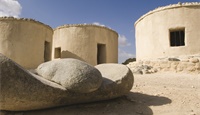
The pre-historic site of Choirokoitia, which was built at the end of the 7th millennium BC, during the Aceramic Neolithic Era, is now situated in Larnaca district. According to recent researches, settlers coming from the mainland inhabited the island during the 8th millennium BC, developing the Aceramic Neolithic Civilisation, of which Choirokoitia is a fine example.
The exceptional architecture of the settlement is visible, even today, on the remains of the structures. The organized collective work is reflected on the enclosure wall that protected the village. The buildings, with a circular shape and a flat roof, were made of mud, sun-dried mudbricks and stone. A group of those circular structures consisted a house. The deceased were buried in a specific way in pits inside the house, accompanied by vessels, so that they remained with the living and their death caused no disruption in the community.
Choirokoitia was included in the World Heritage List for three basic reasons:
- It is the most important archaeological site of the Neolithic period that reflects the expansion,
- the permanent habitations of settlements, and
- the role of Cyprus in the spreading of the Neolithic civilization from the eastern Mediterranean to the West (7th millennium – 4th millennium B.C.)
More information: